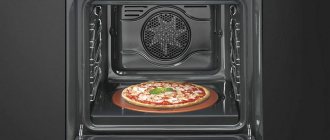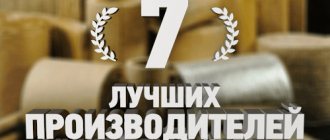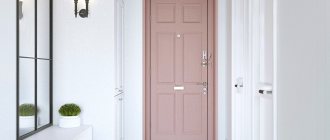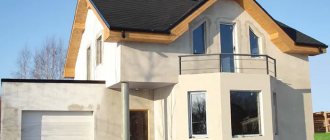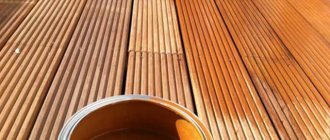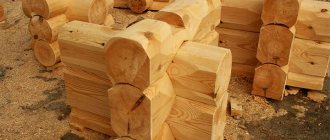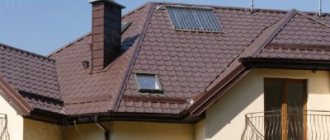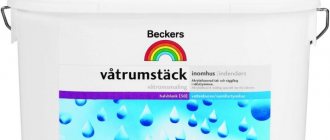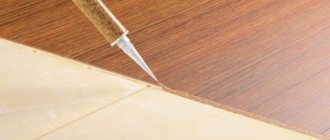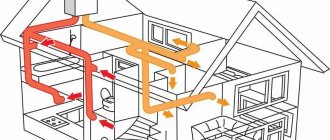Steel sheets that reliably imitate classical roofing ceramics in appearance are in high demand in the field of roofing. Lightness, priority dimensions that allow you to quickly cover large areas, a rich range of colors - qualities that are very attractive both for builders and for owners of low-rise buildings.
A significant addition to the technical and technological advantages is the cost of the material, which can significantly reduce the construction budget. However, not everyone is still familiar with this type of roofing that is so popular today. It will be useful for them to know what metal tiles are, how they are produced, and what their advantages are based on.
Metal tiles
Metal tiles (photo No. 2)
How it is made
Metal tiles are profiled sheets of thin sheet metal. They can be steel, copper or aluminum.
The sheet is covered with a protective coating, most often zinc or aluminum-zinc, but other types of coatings can also be used. This layer protects against corrosion, increases the strength and service life of the material.
The metal tiles are also covered with a protective and decorative polymer coating:
- Polyester
- Acrylate
- Polyurethane
This coating gives the material color and texture, and also protects against external influences: ultraviolet rays and corrosion.
Structure of metal tiles (photo No. 3)
The weight of metal tiles is 4–7 kg/m2.
Advantages of metal tiles
- Large selection of texture, color and profile options
- A light weight. Simplifies the installation of metal tiles; there is no need to strengthen the rafter system
- Reliable corrosion protection. A protective coating made of zinc and aluminum alloys copes well with this task
- Long service life - up to 50 years or more
- Simple installation technology: you can do all the work yourself. A metal roof is also easy to repair.
- You can lay metal tiles even in winter (at sub-zero temperatures)
Disadvantages of metal tiles
- Poor sound insulation. During strong winds, rain or hail, the attic will be noisy
- On complex roofs there may be increased material consumption
- If the protective coating is damaged or insufficiently thick, there is a risk of corrosion.
- High thermal conductivity
!
Note!
When installing metal tiles, it is important to use high-quality seals for self-tapping screws. Poor quality seals deform over time and the roof begins to leak.
Is fame a guarantee of quality? Objective assessment
Previously, metal tiles were associated with the names of famous brands. For example, Monterrey from the Finnish concern Ranilla assumed appropriate product quality. But over time the situation changed. Many manufacturers began to use names consonant with well-known brands. The tricks are simple. The word Monterrey is written with one letter R or the prefix Super is added or written in Russian, slightly changing the order of the letters. The situation is identical with other names. To solve the problem, check quality certificates for raw materials, request strength test reports provided by GOST, use a micrometer and check the reputation of the manufacturer.
Current promotion for premium metal tiles made of Belgian steel - the best price in Ukraine and 25 years warranty!
Ceramic tiles
Ceramic tiles (photo No. 4)
How it is made
Ceramic tiles are a roofing material made from pottery's fusible clay. There are two main production technologies:
- Tape method. A ribbon is made from clay, which is then cut into individual pieces. Tiles produced using this technology have grooves along the tiles.
- Stamping. For this method, special metal molds are used, in which the clay is pressed and blanks of the desired shape are obtained. With this technology, the tiles receive grooves on both sides of the finished tile.
Production of ceramic tiles (photo No. 5)
After the clay has received the desired shape, the blanks go through:
- Drying
- Application of protective coating
- Firing at temperatures over 1000 °C
Ceramic tiles are the heaviest material listed. Its weight is approximately 50 kg/m2.
Advantages of ceramic tiles
- Resistance to high and low temperatures
- Not afraid of exposure to ultraviolet rays
- Not afraid of bacteria and microorganisms
- Slowly heats up and cools down. A good option for houses with an attic
- Heavy weight. Heavy-duty ceramic tile roofing can withstand strong gusts of wind, heavy rain and hail. At the same time, it provides good noise protection
- Durability. Can last for more than 80 years without repair
- Minimum roofing maintenance costs
- Great looks
Disadvantages of ceramic tiles
- Heavy weight. Although we consider this characteristic to be an advantage, there is also a downside. When installing ceramic tiles, you should be sure that the rafters are designed for a load of at least 200–250 kg/m2.
- Low tightness. Between the joints of the tiles, rain or snow may enter the under-roof space. This problem can be easily solved by waterproofing the roof.
- The tiles are quite fragile. Therefore, they must be handled with care during transportation and installation.
- High price
!
Which tiles are best for the roof of a private house?
If your budget allows, it is better to use natural tiles (for example, ceramic). This is a high-quality and reliable material that looks great on a private home.
Manufacturers and equipment
The next significant point in assessing the type of metal tile is the type of equipment on which the product is produced and the manufacturer. If according to the first criterion it is difficult for the average person to make a choice, then the authority of the second is confirmed by various certification systems.
For example, an assessment according to the ISO 9000, 90001 system confirms the compliance of the quality control of manufactured products and management established at the enterprise with certain standards. When choosing a product, it is worth considering that domestic enterprises do not carry out developments in the field of anti-corrosion coatings, but use foreign achievements. At the same time, the equipment at some factories and the production process are not inferior to Western competitors.
Composite tiles
Composite tiles (photo No. 6)
How it is made
Composite tiles are a multilayer roofing material. It is based on steel sheets, which give the sheets a relief shape
- Steel sheets are coated on both sides with a special anti-corrosion coating.
- The next layer of coating is a primer, applied on both sides. From below, this coating protects the anti-corrosion layer from mechanical damage and negative influences of the external environment. On top - improves the adhesion of the base of the sheet with another layer, decorative.
- The decorative layer is an acrylic composition + mineral powder coating.
The acrylic composition gives the tiles a base color and protects them from ultraviolet radiation. A layer of mineral powder is poured onto the acrylic coating. Most often these are basalt chips or small chips of other rocks. The mineral coating performs a decorative function and provides sound insulation of the roof. - Acrylic glaze. The final layer that protects the mineral coating from moisture and wind. This layer is resistant to temperature changes and has self-cleaning properties.
The structure of composite tiles (photo No. 7)
On average, the weight of composite tiles is 6-6.5 kg/m2.
A must-have tool for any installation work. Using a tape measure, you will need to measure the required length of the panel before cutting and laying.
Advantages of composite tiles
- Light weight. There is no need to reinforce the rafter system under a composite roofing tile. This simplifies the roofing technology and eliminates the need for additional costs.
- Thanks to the light weight of the material, installation is faster and easier. Sheets of composite shingles can be lifted manually.
- Reliability and durability. This roof is protected from corrosion, chemical and mechanical influence. Withstands snow loads.
- Retains color. UV resistance provides protection against fading.
- Service life is at least 30-50 years.
- Low thermal conductivity. A comfortable microclimate is maintained in the under-roof rooms both in winter and summer.
- Fire safety. Such tiles do not burn and do not emit toxic substances.
- Good sound insulation is a useful characteristic for attics.
- Environmentally friendly material.
Disadvantages of composite tiles
- Low vapor permeability. When arranging the roof, it is necessary to ensure good ventilation.
- Difficult to care for. The material is plastic, so you need to be careful when moving on the roofing deck.
- Price and cost of installation work. You can save on installation if you do the installation yourself.
Details
Raw materials for the production of metal tiles
At the moment, such coating is made from three types of metals, or rather:
- Copper.
- Become.
- Aluminum.
Galvanized steel helps make the material cheaper because aluminum and copper are non-ferrous metals. The thickness of the sheet in this case will be in the range of 0.045-0.055 cm. As you already understand, the zinc admixture makes the product much more resistant to corrosion. A couple of layers are applied to a rolled steel roof, which makes it stronger. These also include polymer-type protection, which we will discuss further. In addition to pure zinc, a little aluminum is often added to the material, which increases the service life, but also increases the price tag. Aluminum as a raw material is an excellent solution to problems associated with corrosion. This metal is classified as highly alloyed, and therefore there is nothing to be afraid of.
Types of metal roof tiles have high strength and durability. In addition, the sheet mass is so small that you will not need a partner for installation work; you can carry out all procedures yourself. The only drawback will be the scarcity of color solutions and the huge cost. As for copper, all the disadvantages of the metals described above do not apply to it. Such a roof will look extremely noble from the very beginning, and over the years it gains strength, and not vice versa. Due to the patina that appears on copper, they gain excellent resistance to precipitation and other weather conditions. The service life of the material is more than 200 years, and the cost of such metal tiles will be extremely high, but if you look at the operation, it will become clear what you are paying for.
Types of metal tiles
Now I want to talk about popular types, and all developers liked these types of metal tiles at just one glance and even now are in incredibly high demand. As for new products, there are more and more of them every year, but not all types of coatings deserve attention. Among the new types of metal tiles, it is worth highlighting Shanghai and Andalusia.
Monterrey
The country of manufacture of such coating will be Finland. The sheet surface is distinguished by its strong similarity to natural type tiles, which influenced its popularity. Such metal tiles are lightweight and also very beautiful. As for the installation work, there are no problems with it at all stages. Using such a roof is a real pleasure, because it is unpretentious in maintenance and with the correct slope of the roof slope, precipitation will be removed naturally.
Cascade
Almost all the guests who drop by will start joking and asking: “Why did you decide to put chocolate on the roof?” The similarity of sheets of such metal tiles with a chocolate bar is almost 100%. The cascade stands out for its ideal proportions and sharp edges, which will make it much more convenient to cover roof frames with complex shapes. A building covered with such material acquires strict outlines, unusual proportions and neatness. If we consider this variety from a different point of view, we can say that this is a classic look that will always be relevant.
Joker
A distinctive feature of this material is the recessed ridge and sole. Such sheet waves create a more natural imitation of real tiles, but with their own beauty. Joker combines modernity and classic elegance, and therefore, if you adore such styles, then you will definitely like it.
Banga
The last most popular type of metal tiles is produced under the name “Banga”. Despite the fact that it was produced relatively long ago, it is still considered a new product. The sheet profile of Banga has unusual and elaborate shapes, for which a large number of developers fell in love with it. The ideally arranged sheet form makes it possible to create convex images. The only drawback will be the small sheet width, due to which you will need to spend more time on installation work.
Andalusia
In the photo of types of metal roof tiles, Andalusia stands out separately. It quickly became an extremely popular material in our country, and special European equipment is used for sheet production, and therefore the quality of such coating is ideal. As for the installation work, in this case it may take place along a different channel. Invisible fastening makes this type extremely popular, because even the most popular materials are fastened from the outside. Due to the snap lock under the roofing sheet, the surface will have very high aesthetics and waterproofing.
Shanghai
The name of this type of metal tile speaks for itself, since it was produced in China. Such products have existed in this country for a very long time, but in Russia they learned about the material only 2 years ago. A distinctive feature of the visual design will be the extremely high profile, which is 6.6 cm and has symmetry. All of the types of metal roofing tiles listed above are extremely popular, and all developers should know about them, or at least distinguish them from the photo. Next, we propose to consider the types of protective coatings that will make it easier for the metal to withstand all the difficulties of weather conditions.
Bituminous shingles
Bituminous (or flexible) tiles Alta-Profile (photo No. 9)
How it is made
Bitumen shingles are one of the most popular types of soft roofing. This material is based on a dense fiberglass sheet, which is impregnated with high-quality bitumen with polymer additives. The following types of bitumen can be used:
- SBS-modified bitumen - with the addition of artificial rubber. This additive increases the elasticity of bitumen, resistance to severe frosts and high temperatures, as well as ultraviolet rays.
- Oxidized bitumen (enriched with oxygen). This bitumen is less flexible, but cheaper.
The top of the canvas is covered with fine-grained topping made of natural slate or basalt. Powder functions:
- Protects bitumen from ultraviolet radiation and strong heat (prevents bitumen from melting)
- Protects coatings from mechanical damage - birds, tree branches, hail, snow, etc.
- Increases strength
- Shapes the appearance - there are many options for color shades of the coating
The weight of bitumen shingles is from 6 to 15 kg/m2.
Advantages of bituminous shingles
Advantages of Alta-Profile tiles (photo No. 10)
- The warranty, depending on the manufacturer, ranges from 20 to 50 years.
- Suitable for installation of complex roofs. There is virtually no waste left during installation.
- Excellent sound insulation. Reduces noise from rain and hail.
- Fire resistance. The material does not burn well and does not ignite.
- Light weight. There is no need to strengthen the rafter structure.
- Large selection of shades
- The material is light and compact - easy to transport.
Disadvantages of bitumen shingles
- When laying bitumen shingles, a base of the underlying layer is required. This slightly increases the cost and scope of work.
- If the roof slope is less than 13 °, you need to use an additional underlay to protect the roof from moisture.
- Softens at high temperatures. It is not recommended to install bitumen shingles in hot weather. Also, in extreme heat, you should not move on such a roof.
- If the coating is damaged, it is difficult to make a partial replacement.
- Light weight. There is no need to strengthen the rafter structure.
- Large selection of shades
- The material is light and compact - easy to transport.
The underlying layer for flexible tiles from Alta-Profil (photo No. 11)
Specifics in preparing the base for laying
In fact, under all types of tiled roofing, sparse sheathing is installed. Its step depends on the size of the element.
It is necessary that each tile rests on at least three laths: at the top, in the middle, and at the bottom. The choice of timber for lathing depends on the weight of the covering.
Tiles of clay, concrete and polymer-sand tiles are fixed to the laths using mounting elements laid during the production process and wire. Simply put, they are screwed individually to the sheathing bar. The composite material is nailed down.
Only flexible bitumen shingles are attached over a continuous sheathing constructed from boards, plywood or OSB panels. This fact somewhat reduces the economic benefits of budget roofing, but significantly increases the insulating benefits of the roof.
When installing all roofing systems, except again for a roof with bitumen shingles, it is necessary to ensure ventilation of the space between the roof and the insulating pie, if there is one, or waterproofing, if there is no insulation. Ventilation in the form of vents is ensured by laying counter-lattice.
All types of roofing are used in the construction of cold and insulated attic roofs. All types of coating require waterproofing, which is currently used as a superdiffusion membrane. It allows condensation to pass out, but prevents atmospheric water from passing in.
The exception is the same flexible tiles. This material itself forms a continuous water-repellent coating. But its installers do not completely abandon waterproofing; they use a waterproofing barrier along the structural lines of the roof: ribs, valleys, eaves.
Important factors when choosing roofing tiles
Before choosing tiles for your roof, it is important to consider:
- Material service life and warranty period.
The longer the better. - Installation features.
To install some types of tiles, you will need the help of specialists. And these are additional costs. - The weight of the tiles and the technical characteristics of the building.
It should be remembered that the roofing is an additional load on the floors and foundation. And some types of tiles are quite heavy and the load is significant. Therefore, ceramic tiles, for example, should not be used when arranging the roof of a relatively light wooden house. - Climate.
The shingles must be designed for use in your climate region. - Price.
When calculating the cost of roofing, you need to take into account not only the cost of the tiles, but also the installation devices, as well as the installation work itself.
!
Don't chase too low a price. The quality of the roofing directly determines how long the entire roof will last and the comfort in the house.
Comparison with other materials
Despite the variety of hard and soft roofing materials, metal tiles still remain an extremely popular option. This is due to a number of its advantages over competitors. So, compared to soft bitumen roofing, metal tiles are more durable and resistant to negative environmental factors, fireproof, and most importantly - much cheaper.
Metal tiles outperform Euroslate (aka ondulin) in terms of service life by an average of 10 years. It retains its shade longer, and the color range is much more varied than that of ondulin.
Metal tiles are superior to a number of solid roofing materials, among which is its prototype - ceramic tiles. Metal is superior to ceramics in strength, durability, ease of installation, unpretentiousness to operating conditions, and cost.

